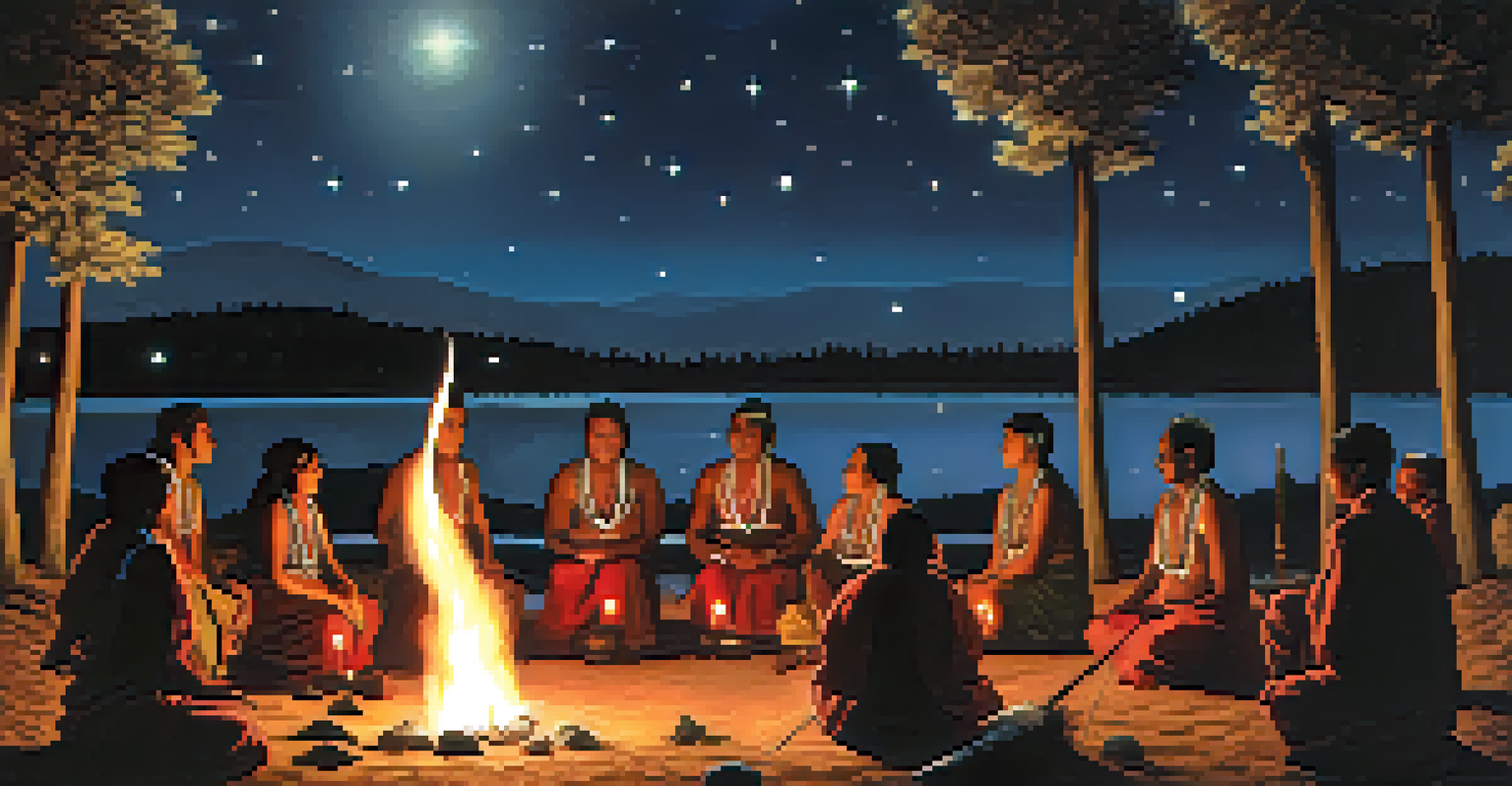Indigenous Wisdom: The Cosmos in Native Spiritual Traditions

Understanding Indigenous Wisdom and Its Connection to the Cosmos
Indigenous wisdom embodies a rich tapestry of knowledge passed down through generations. At its core, this wisdom emphasizes the interconnectedness of all beings and the universe. Many Native cultures view the cosmos as a living entity, where stars, planets, and natural elements hold significant meaning and stories.
We do not inherit the earth from our ancestors; we borrow it from our children.
This relationship with the cosmos shapes their understanding of existence and influences daily practices. For example, celestial events are often linked to agricultural cycles, guiding when to plant or harvest. By recognizing these patterns, Indigenous peoples maintain a harmonious relationship with nature and the universe.
Thus, Indigenous wisdom encourages us to see beyond the material world. It invites us to reflect on our own connections to the cosmos, fostering a sense of responsibility for the Earth. In this way, Indigenous spiritual traditions offer profound insights for navigating contemporary challenges.
The Role of Storytelling in Indigenous Cosmology
Storytelling is a vital aspect of Indigenous cultures, serving as a powerful vehicle for sharing cosmological views. Through oral traditions, generations pass down tales that explain the origins of the universe, human beings, and the relationships among all living things. These stories often feature animals, spirits, and celestial bodies, intertwining lessons about life and the cosmos.

For instance, many Native American tribes have creation stories that illustrate how the Earth and sky came to be. These narratives not only entertain but also impart wisdom about respect for nature and the universe. They remind listeners of their place within a larger framework, fostering a sense of belonging and purpose.
Indigenous Wisdom and the Cosmos
Indigenous wisdom emphasizes the deep interconnectedness of all beings and the universe, guiding daily practices and fostering a sense of responsibility for the Earth.
Moreover, storytelling helps preserve cultural identity and values. In a rapidly changing world, these narratives serve as anchors, connecting individuals to their heritage and the cosmos. They illustrate the importance of maintaining a dialogue with the universe through traditions passed down over time.
Celestial Bodies in Indigenous Spiritual Practices
Celestial bodies play a crucial role in Indigenous spiritual practices, often viewed as guides or ancestors. The sun, moon, stars, and planets are not just physical entities but are imbued with spiritual significance. For many Indigenous cultures, the movements of these celestial bodies are seen as reflections of life on Earth.
The Earth does not belong to us; we belong to the Earth.
For example, the cycles of the moon are closely observed and honored in various rituals. Many tribes align their ceremonies with lunar phases, believing that these cycles influence growth, healing, and transformation. This practice underscores the harmony between earthly life and cosmic rhythms.
Additionally, Indigenous peoples often create star maps and calendars that reflect their understanding of the universe. These tools serve not only practical purposes but also enhance spiritual connections. By aligning their lives with the cosmos, they cultivate a profound sense of belonging to the larger universe.
Nature as a Reflection of Cosmic Principles
In Indigenous spirituality, nature is often seen as a direct reflection of cosmic principles. Every element, from the smallest pebble to the tallest mountain, carries a story and wisdom that echoes the universe's design. This belief fosters a deep respect for the environment, encouraging sustainable practices.
For instance, many Indigenous cultures view rivers as the lifeblood of the Earth, reflecting the flow of the universe. This perspective shifts how they engage with natural resources, emphasizing stewardship over exploitation. By recognizing nature's sacredness, they cultivate a sense of responsibility to protect it.
Storytelling's Role in Culture
Storytelling serves as a vital means of preserving Indigenous cosmological views, connecting individuals to their heritage and the cosmos through shared narratives.
Moreover, this worldview promotes a holistic understanding of existence. It teaches that every action has a ripple effect, not just on the planet but also in the cosmos. By embracing this interconnectedness, Indigenous peoples inspire others to consider their impact on the world around them.
Rituals and Ceremonies Honoring Cosmic Forces
Rituals and ceremonies are integral to Indigenous spiritual practices, often designed to honor cosmic forces. These events create sacred space where participants connect with the universe and seek guidance from celestial beings. Rituals can range from seasonal celebrations to personal rites of passage.
For example, some tribes hold ceremonies during solstices and equinoxes, marking significant moments in the cosmic calendar. These gatherings emphasize gratitude and reflection, allowing participants to align their intentions with the universe's rhythms. Such practices reinforce community bonds and deepen spiritual connections.
Moreover, rituals often incorporate elements of nature, such as water, fire, and earth. By engaging with these elements, participants acknowledge their relationship with the cosmos and the cycles of life. This connection fosters a sense of unity with the universe, reminding individuals of their place within the grand tapestry of existence.
The Wisdom of Seasons in Indigenous Traditions
Indigenous traditions place great emphasis on the changing seasons, viewing them as teachers of cosmic wisdom. Each season carries its own lessons, rhythms, and energies that guide Indigenous peoples in their daily lives. Understanding these seasonal changes is crucial for agriculture, hunting, and spiritual practices.
For instance, spring is often associated with renewal and rebirth, while autumn signifies reflection and gratitude. By recognizing these seasonal patterns, Indigenous communities align their activities with the natural world. This alignment fosters a deeper connection to the land and the cosmos, enhancing their understanding of the cycles of life.
Celestial Bodies in Spirituality
Celestial bodies are viewed as spiritual guides in Indigenous practices, influencing rituals and promoting harmony between earthly life and cosmic rhythms.
Additionally, the wisdom of the seasons encourages mindfulness and presence. It teaches individuals to honor the present moment while also acknowledging the larger cosmic cycles at play. This holistic approach to time and existence reinforces the importance of living in harmony with the universe.
Contemporary Relevance of Indigenous Cosmic Wisdom
The wisdom of Indigenous peoples regarding the cosmos holds profound relevance in today's world. As we face environmental crises and societal challenges, these teachings offer valuable insights for sustainable living. By embracing the interconnectedness emphasized in Indigenous traditions, we can foster a deeper understanding of our impact on the planet.
Furthermore, Indigenous wisdom encourages us to cultivate respect for all forms of life. This perspective challenges the dominant narrative of separation between humans and nature, urging us to see ourselves as part of a larger ecosystem. Such a shift in mindset can inspire collective action towards healing the Earth.

Incorporating Indigenous teachings into contemporary practices promotes resilience and sustainability. By learning from these ancient wisdoms, we can create a more balanced relationship with the cosmos. Ultimately, this journey invites us to reflect on our place in the universe and how we can contribute to its harmony.